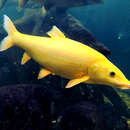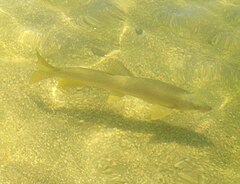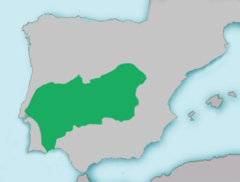fi
nimet breadcrumb-navigoinnissa


El barb ibèric (Luciobarbus comizo) és una espècie de peix de la família dels ciprínids i de l'ordre dels cipriniformes. Els mascles poden assolir els 40 cm de longitud total.[4] Es troba a la península Ibèrica (rius Tajo, Guadiana i Guadalquivir).[5][4] Es troba amenaçat d'extinció per la pèrdua del seu hàbitat natural, la contaminació i la introducció de noves espècies.[6]
El barb ibèric (Luciobarbus comizo) és una espècie de peix de la família dels ciprínids i de l'ordre dels cipriniformes. Els mascles poden assolir els 40 cm de longitud total. Es troba a la península Ibèrica (rius Tajo, Guadiana i Guadalquivir). Es troba amenaçat d'extinció per la pèrdua del seu hàbitat natural, la contaminació i la introducció de noves espècies.
Die Iberische Barbe (Luciobarbus comizo) gehört zu den großen Karpfenfischen, die endemisch auf der Iberischen Halbinsel beheimatet sind.[1] In Portugal wird sie Barbo-Focinheiro[2] und in Spanien Barbo Comizo oder Comiza genannt.[1]
Die Iberischen Barben sind stromlinienförmige und schlanke Fische. Sie ähneln vom Aussehen her stark der europäischen Flußbarbe. Der Körper ist goldgelb gefärbt. Ihre Brust-, Bauch- und Afterflossen haben einen leichten orange bis rötlichen Ansatz. Die beiden Bartelpaare sind um das unterständige Maul angeordnet. Der längste Strahl der Rückenflosse ist steif und hat einen gesägten Hinterrand. An der Seitenlinie sind 49 bis 51 Schuppen angeordnet.[3] Männchen und Weibchen zeigen einen geschlechtstypischen Dimorphismus.[4] Während der Laichzeit bilden sie einen für Karpfenfische typischen Laichausschlag aus. Die Iberische Barbe wird gewöhnlich bis 50 Zentimeter lang, in Ausnahmefällen jedoch wesentlich größer, bis 80 Zentimeter und mehr.[1] Bis zu 18 Kilogramm schwere Exemplare wurden in den Flüssen Rio Tajo, Rio Guadiana und Rio Guadalquivir gefangen.[5]
Die Iberische Barbe ist auf der Iberischen Halbinsel in Spanien und Portugal verbreitet. Sie bewohnt die langsamfließenden Unterläufe und Staubecken der großen Flüsse wie dem Rio Tajo, Rio Guadiana und Rio Guadalquivir. Im Guadalquivir-Flussbecken gilt sie jedoch schon als fast ausgestorben.[1] Im Rio Almonte und Rio Guadiana gibt es noch einen ausreichenden Bestand.[6] Luciobarbus comizo bevorzugt tiefes und stehendes Wasser mit einer üppigen Unterwasservegetation.[7]
Die Iberische Barbe ernährt sich an Grundnähe von Pflanzen, Kleintieren und kleineren Fischen. Während Jungfische überwiegend noch Wirbellose fressen, spezialisieren sich adulte Exemplare mit zunehmender Größe als Raubfische auf kleine Beutefische. Die Laichzeit findet im Frühling, in den Monaten Mai bis Juni statt.[1]
Dort wo die Iberische Barbe noch häufig vorkommt, ist sie wegen ihrer Größe und Kampfkraft ein beliebter Sportfisch für Angler.
Die Iberische Barbe gilt als gefährdet[8] und wird in der Berner Konvention, Anhang III, als schützenswerte Fischart aufgeführt. Es wird angenommen, dass die Population von L. comizo in den letzten zehn Jahren seit ungefähr 1990 um 30 % zurückging. Schuld daran sind eine unkontrollierte Wasserentnahme für die landwirtschaftliche Bewässerung, Gewässerverschmutzung, Dammbau, anthropogene Veränderung deren Mikrohabitate und eingeführte fremde Fischarten, dies hat zu einem kontinuierlichen Rückgang der Individuendichte und Verbreitungsgebiet geführt. Der Bau von Staudämmen hatte jedoch auch den positiven Effekt, dass die künstliche Schaffung von ruhigen Gewässerzonen die Fortpflanzungsrate der Fischart ansteigen ließ.[9]
Die Iberische Barbe wird von der Europäischen Union im Anhang II der FFH-Richtlinie geführt und gilt damit als Art von gemeinschaftlichem Interesse, für deren Erhaltung von den Mitgliedsstaaten besondere Schutzgebiete ausgewiesen werden müssen.
Gemäß der Klassifikation der IUCN gehört sie zur Gattung Luciobarbus.[10] Diese ist jedoch auch relativ nah mit Vertretern der Gattung Barbus verwandt und wird deswegen auch manchmal als eine Untergattung der Gattung Barbus eingestuft. Im Mittellauf des Rio Tajo kommt es sehr häufig zur natürlichen Hybridisierung mit anderen Iberischen Barbenarten wie zum Beispiel Luciobarbus bocagei. Diese Hybridisierung erschwert phylogenetische Studien, die mithilfe von mitochondrialer DNS durchgeführt werden.[11] Die Art kommt seit 800.000 bis 1.000.000 Jahren im Rio Tajo vor.[12]
Die Iberische Barbe (Luciobarbus comizo) gehört zu den großen Karpfenfischen, die endemisch auf der Iberischen Halbinsel beheimatet sind. In Portugal wird sie Barbo-Focinheiro und in Spanien Barbo Comizo oder Comiza genannt.
The Iberian barbel (Luciobarbus comizo) is a ray-finned fish species in the family Cyprinidae. It is here placed in Luciobarbus following the IUCN, but that genus is very closely related to the other typical barbels and perhaps better considered a mere subgenus of Barbus. This large barbel can grow to over 50 cm (20 in) long.[2]
Natural hybrids of this barbel and the closely related L. bocagei are not uncommon in the middle Tagus river. The two species and their hybrids are hard to distinguish, but L. comizo has a longer and more narrow, and the last unbranched ray of the dorsal fin has a longer denticulated section but with more widely spaced denticles. In the first two traits the hybrids are intermediate between their parent species, in the latter they are closer to the Iberian Barbel. Also, the two species are distinguished by their microhabitat preferences where they are sympatric, with L. bocagei inhabiting somewhat faster-moving parts of the river. The hybridisation confounds phylogenetic studies based only on mtDNA.[3]
L. comizo is endemic to the Iberian Peninsula, where it occurs in both Portugal and Spain. It inhabits the slow-moving middle and lower parts of rivers and reservoirs in the Tagus' and the Guadiana Rivers' drainage basins. Its habitat are deep and almost stagnant waters with abundant aquatic vegetation[4]
Its numbers have declined by about one-third since the 1990s due to unsustainable water usage for agriculture, pollution and competition with introduced species. Whether hybridisation with the more numerous L. bocagei also affects its numbers is not known. The two must have achieved reproductive isolation in the past to become as disting as they are, but damming and other construction have in recent times shifted the river's currents and changed microhabitat, so that these barbels will now meet at spawning sites more often. Altogether however, damming will slow the river's flow to almost a standstill, creating conditions more favourable to the Iberian Barbel than to L. bocagei, and the hybridisation may actually be a sign of the rarer species becoming more plentiful.[5]
In any case, the unsustainable extraction of for agriculture is the main threat of L. comizo. It is by no means as common as it was in past times, and classified as a Vulnerable by the IUCN. It is listed in Annex II of the European Union's Habitats Directive as a Species Requiring Designation of Special Conservation Areas, and in Annex V to allow for legal restrictions to its taking. It is also named as Protected Species in Appendix III of the Convention on the Conservation of European Wildlife and Natural Habitats.[4]
The Iberian barbel (Luciobarbus comizo) is a ray-finned fish species in the family Cyprinidae. It is here placed in Luciobarbus following the IUCN, but that genus is very closely related to the other typical barbels and perhaps better considered a mere subgenus of Barbus. This large barbel can grow to over 50 cm (20 in) long.
Natural hybrids of this barbel and the closely related L. bocagei are not uncommon in the middle Tagus river. The two species and their hybrids are hard to distinguish, but L. comizo has a longer and more narrow, and the last unbranched ray of the dorsal fin has a longer denticulated section but with more widely spaced denticles. In the first two traits the hybrids are intermediate between their parent species, in the latter they are closer to the Iberian Barbel. Also, the two species are distinguished by their microhabitat preferences where they are sympatric, with L. bocagei inhabiting somewhat faster-moving parts of the river. The hybridisation confounds phylogenetic studies based only on mtDNA.
 Yellow specimen
Yellow specimen L. comizo is endemic to the Iberian Peninsula, where it occurs in both Portugal and Spain. It inhabits the slow-moving middle and lower parts of rivers and reservoirs in the Tagus' and the Guadiana Rivers' drainage basins. Its habitat are deep and almost stagnant waters with abundant aquatic vegetation
Its numbers have declined by about one-third since the 1990s due to unsustainable water usage for agriculture, pollution and competition with introduced species. Whether hybridisation with the more numerous L. bocagei also affects its numbers is not known. The two must have achieved reproductive isolation in the past to become as disting as they are, but damming and other construction have in recent times shifted the river's currents and changed microhabitat, so that these barbels will now meet at spawning sites more often. Altogether however, damming will slow the river's flow to almost a standstill, creating conditions more favourable to the Iberian Barbel than to L. bocagei, and the hybridisation may actually be a sign of the rarer species becoming more plentiful.
In any case, the unsustainable extraction of for agriculture is the main threat of L. comizo. It is by no means as common as it was in past times, and classified as a Vulnerable by the IUCN. It is listed in Annex II of the European Union's Habitats Directive as a Species Requiring Designation of Special Conservation Areas, and in Annex V to allow for legal restrictions to its taking. It is also named as Protected Species in Appendix III of the Convention on the Conservation of European Wildlife and Natural Habitats.
El barbo comizo (Luciobarbus comizo)[1] es una especie de pez de la familia Cyprinidae endémica de la península ibérica.
Es una de las especies del género Luciobarbus más grandes, conociéndose ejemplares que superan el metro de longitud total. Su cuerpo es alargado sobre todo en la región caudal donde se estrecha mucho.
Se diferencia de otras especies de la Península, por el notable alargamiento que sufre la cabeza al crecer los individuos, teniendo el hocico muy desarrollado, las barbillas son cortas, en relación a la cabeza. Las hembras presentan una aleta anal más larga que los machos y alcanzan mayor tamaño. En la época de reproducción, de mayo a junio, los machos muestran unos tubérculos nupciales muy acentuados en la parte anterior de la cabeza.
Endemismo de la península ibérica, solo hábita en España y Portugal. En España solo vive en las cuencas de los ríos Tajo y Guadiana, existen citas en el bajo Guadalquivir y en el Ebro, pero en estas áreas parece haberse extinguido.
El barbo comizo, prefiere ríos profundos y con poca velocidad de corriente. Por esta razón se ve favorecido con la construcción de embalses, con respecto a otras especies del género. Tiene hábitos alimenticios planctónicos consumiendo preferentemente insectos y ocasionalmente otros peces.
La introducción de especies exóticas, la mayoría de ellas piscívoras, en los ríos españoles es su mayor amenaza, además las influencia en su hábitat con la realización de obras hidráulicas, la contaminación por vertidos industriales, urbanos y agrícolas, la extracción de agua de los ríos para fines agrícolas, sin las debidas precauciones y la extracción de áridos que destruyen los frezaderos.
El barbo comizo (Luciobarbus comizo) es una especie de pez de la familia Cyprinidae endémica de la península ibérica.
Luciobarbus comizo Luciobarbus generoko animalia da. Arrainen barruko Actinopterygii klasean sailkatzen da, Cyprinidae familian.
Luciobarbus comizo Luciobarbus generoko animalia da. Arrainen barruko Actinopterygii klasean sailkatzen da, Cyprinidae familian.
Luciobarbus comizo o barbo iberico è un pesce osseo d'acqua dolce della famiglia Cyprinidae.
È una specie endemica della penisola Iberica occidentale, precisamente dei fiumi Tago e Guadiana mentre risulta estinto nel Guadalquivir (tranne, forse, nel tratto terminale).
Popola i grandi fiumi larghi e profondi, in tratti con corrente lenta e abbondante vegetazione acquatica.
Questo barbo è immediatamente riconoscibile dai congeneri a causa del profilo della testa che è molto allungato e, negli adulti, concavo tra la bocca e l'occhio. Gli occhi sono molto vicini al profilo dorsale. L'ultimo raggio della pinna dorsale è rigido e robustamente seghettato sul bordo posteriore. Labbra sottili.
Si tratta di uno dei più grandi barbi europei raggiungendo gli 80 cm di lunghezza.
Si ciba di invertebrati in età giovanile mentre da adulto, fatto inusuale per un barbo, preda soprattutto pesci.
Si riproduce probabilmente in primavera.
Le popolazioni si sono fortemente ridotte negli ultimi anni. È minacciato dall'alterazione dell'habitat, dalla diminuzione di portata dei fiumi a causa dell'estrazione di acqua e dall'introduzione di specie aliene.
Luciobarbus comizo o barbo iberico è un pesce osseo d'acqua dolce della famiglia Cyprinidae.
Luciobarbus comizo is een straalvinnige vissensoort uit de familie van de eigenlijke karpers (Cyprinidae).[1] De wetenschappelijke naam van de soort is voor het eerst geldig gepubliceerd in 1864 door Steindachner.
Bronnen, noten en/of referentiesLuciobarbus comizo er en art av karpefisker.
Luciobarbus er tetraploid med 2n = 4x = 100 kromosomer. De er mellomstore til svært store fisker med fire skjeggtråder rundt den overbitte munnen.
Klassifikasjon etter WoRMS 2017.[3]
Luciobarbus comizo er en art av karpefisker.
Luciobarbus er tetraploid med 2n = 4x = 100 kromosomer. De er mellomstore til svært store fisker med fire skjeggtråder rundt den overbitte munnen.
 Systematyka Domena eukarionty Królestwo zwierzęta Typ strunowce Gromada promieniopłetwe Rząd karpiokształtne Rodzina karpiowate Rodzaj Luciobarbus Gatunek brzana iberyjska Synonimy
Systematyka Domena eukarionty Królestwo zwierzęta Typ strunowce Gromada promieniopłetwe Rząd karpiokształtne Rodzina karpiowate Rodzaj Luciobarbus Gatunek brzana iberyjska Synonimy 

Brzana iberyjska[3] (Luciobarbus comizo) – gatunek ryby z rodziny karpiowatych (Cyprinidae).
Południowa część Półwyspu Iberyjskiego, w dorzeczach rzek Tajo, Jarama, Guadiana i Gwadalkiwir. Żyje stadnie, w pobliżu dna, w miejscach o wartkim prądzie i piaszczystym lub żwirowym podłożu.
Osiąga 20–30 (maksymalnie 40) cm długości. Brzuch prosty, kark wypukły. Głowa niska, szeroka, spłaszczona grzbietobrzusznie. Pysk płaski, szeroki. Otwór gębowy dolny, wargi cienkie. Wąsiki 4 cienkie i krótkie, przednie nie sięgają oka. Łuski duże, 49–51 wzdłuż linii bocznej. W płetwie grzbietowej 11–12 promieni. Pierwszy jest silnie pogrubiony, z piłkowaną tylną krawędzią. W płetwie odbytowej 8 promieni. Zęby gardłowe trójrzędowe o wzorze 5.3.2–2.3.5.
Ubarwienie bardzo zmienne. Grzbiet ciemny, zielonobrązowy do zielonoszarego, boki jaśniejsze, srebrzyście lśniące. Brzuch białawy.
Żywi się fauną denną (robaki, skorupiaki, mięczaki), ikra (zwłaszcza w młodszym wieku) oraz rośliny.
Tarło od IV do VI odbywa się na płytkich, żwirowych łachach w silnym prądzie.
Brzana iberyjska (Luciobarbus comizo) – gatunek ryby z rodziny karpiowatych (Cyprinidae).
Luciobarbus comizo é uma espécie de peixe pertencente à família Cyprinidae.
A autoridade científica da espécie é Steindachner, tendo sido descrita no ano de 1864.
Encontra-se presente em Portugal, onde é uma espécie nativa.
O seu nome comum é barbo-focinheiro.
Trata-se de uma espécie de água doce. Atinge os 80 cm de comprimento padrão, com base de indivíduos de sexo indeterminado.
Luciobarbus comizo é uma espécie de peixe pertencente à família Cyprinidae.
A autoridade científica da espécie é Steindachner, tendo sido descrita no ano de 1864.